You might be surprised to learn that the first person on Earth to die is often thought to be Abel, the son of Adam and Eve, according to biblical accounts. His death represents the earliest recorded instance of murder in history, committed by his brother Cain out of jealousy. This story serves as an important narrative about morality and the consequences of sin, highlighting how death deeply intertwines with human experience. If you want to explore more about early human deaths and the evolution of burial practices, there's plenty more to discover.
Essential Insights
- The concept of the "first person to die" is largely theological and varies across different religious beliefs, particularly in Judeo-Christian contexts.
- In the Bible, Abel is often considered the first person to die, killed by his brother Cain, reflecting early human conflict.
- Fossil evidence suggests early hominins, like *Homo erectus*, existed for millions of years before recorded history, making it difficult to identify a "first" individual.
- Prehistoric mortality rates indicate that many early humans died young due to disease, injuries, and malnutrition, complicating the idea of a singular first death.
- The understanding of death has evolved, with burial practices reflecting cultural beliefs, but no definitive record exists of the first human death.
Historical and Biblical Accounts
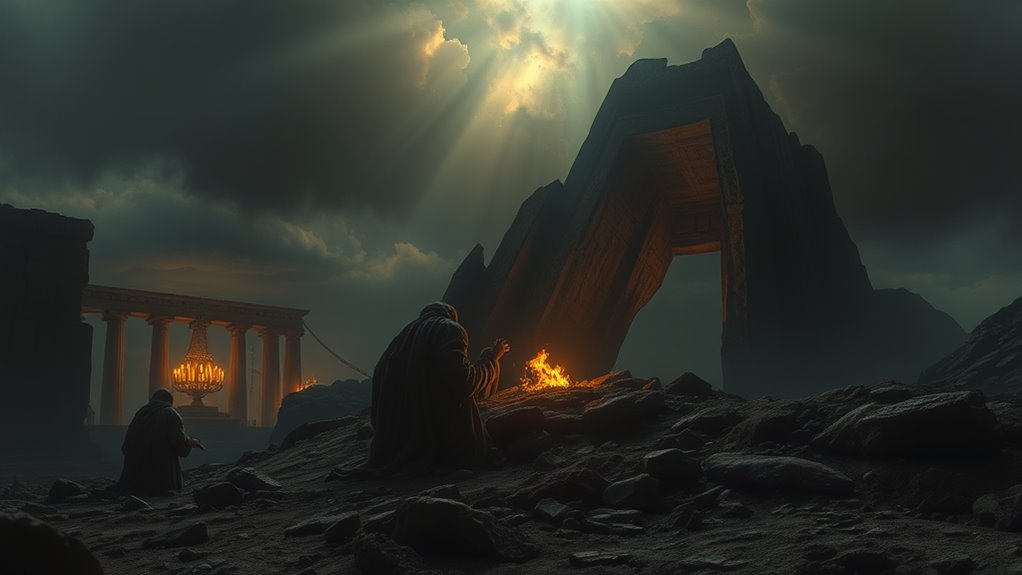
The historical and biblical accounts of death offer fascinating insights into how humanity has understood mortality. You might find it intriguing that the first recorded death in a vehicle accident belongs to Mary Ward, who tragically lost her life on August 31, 1869, in Ireland. While riding in a steam-powered carriage designed by William Rose, a sudden jolt threw her under the heavy wheels, leading to an inquest that deemed her death accidental.
The Kings County Chronicle reported her passing with high regard, marking a significant moment in transportation history.
In contrast, biblical accounts address death from a theological perspective. They don't pinpoint the first person to die but suggest that death entered the world through Adam's sin, according to Christian belief. John Calvin argued that Adam's sin resulted in the painful, abrupt death we experience today, rather than a gentle change. This aligns with the belief that death is a consequence of sin, emphasizing the separation of the soul from the body.
The Bible portrays death as a consequence of sin, emphasizing the separation of the soul from the body. This separation, outlined in scripture, introduces the concepts of "first death" and "second death." The "first death" refers to physical death, while the "second death" signifies spiritual separation from God.
In this context, you can see how both Mary Ward's tragic accident and biblical death shape our understanding of mortality, highlighting a blend of historical events and profound theological interpretations that continue to influence our perception of life and death today.
Fossil and Archaeological Evidence
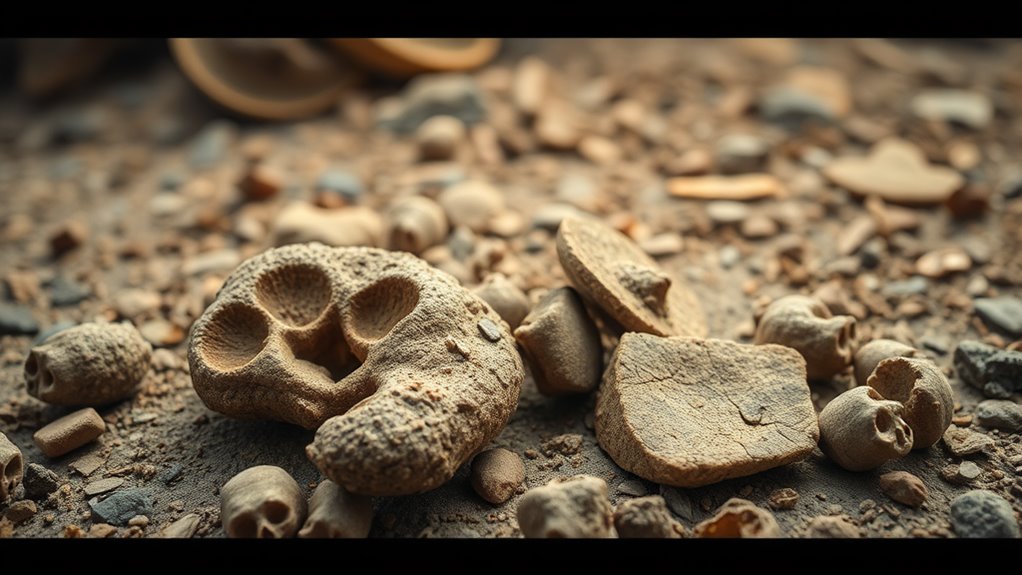
While exploring the origins of human mortality, fossil and archaeological evidence reveals critical insights into our ancestors' lives and deaths. Fossil discoveries, such as the *Homo erectus* remains found on the Indonesian island of Java, provide a glimpse into the physical attributes of early humans. These fossils, including an isolated tooth and a skull fragment, date back approximately 1.8 million years. They show that while our ancestors had an erect posture, their brain sizes were considerably smaller than those of modern humans. Homo erectus is notable for being the longest-lived human species, surviving over 1.5 million years.
Additional fossils from Dmanisi, Georgia, present a variety of skeletal parts, highlighting the diversity among early human species.
On the other hand, archaeological evidence sheds light on the health challenges faced by ancient populations. Remarkably, the discovery of a 3,000-year-old skeleton in Sudan reveals the presence of metastatic cancer in ancient humans. This skeleton, found by a Durham University PhD student, indicates that diseases like cancer existed long before modern medical practices. Reported in *PLOS ONE*, this finding challenges the notion that such illnesses are solely contemporary issues.
Together, these fossil and archaeological findings inform us about the struggles and conditions that shaped early human existence. They emphasize not just the physical evolution of our ancestors but also the impact of ancient diseases on their mortality. Understanding these factors helps paint a clearer picture of life and death in our early history.
Prehistoric Mortality Rates
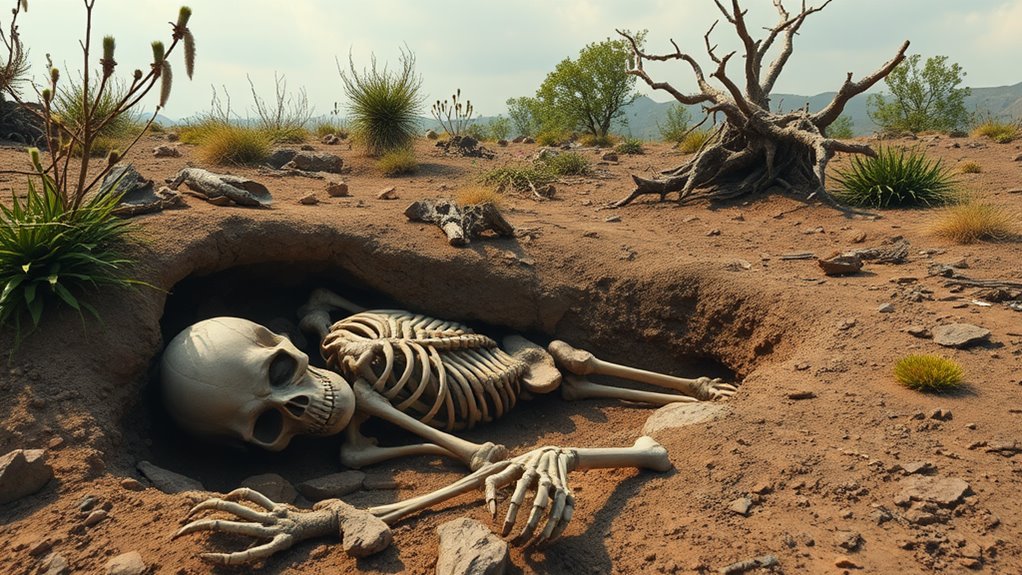
Understanding prehistoric mortality rates reveals a stark reality about early human life. Life expectancy during the Paleolithic and Neolithic eras was shockingly low, averaging just 22 to 33 years. High infant mortality rates skewed these statistics, making survival beyond the early years a significant feat.
If you made it to age 15, your odds improved: life expectancy jumped to around 28 to 36 years during the Bronze and Iron Ages. However, this doesn't paint a complete picture of your ancient ancestors' lives.
Prehistoric death causes primarily revolved around diseases, injuries, and malnutrition. Common ailments like osteoarthritis and rickets emerged from lifestyle choices and nutritional deficiencies. Without antiseptics or proper medical facilities, even minor injuries could lead to severe complications. Public health measures were virtually nonexistent, contributing to the overall low life expectancy in these eras.
Women faced additional risks; childbirth was a leading cause of mortality, as archaeological finds often show women and infants buried together, highlighting the dangers of ancient health challenges.
Despite the grim statistics, many prehistoric humans could live into their 60s or 70s if they survived childhood. Once you removed the high infant mortality rates from the equation, it becomes clear that life expectancy could be far more generous for those who made it past early vulnerabilities.
This nuanced understanding of prehistoric mortality rates helps you appreciate how resilience and survival were essential traits for early humans maneuvering a perilous world.
Evolutionary Timeline of Humans
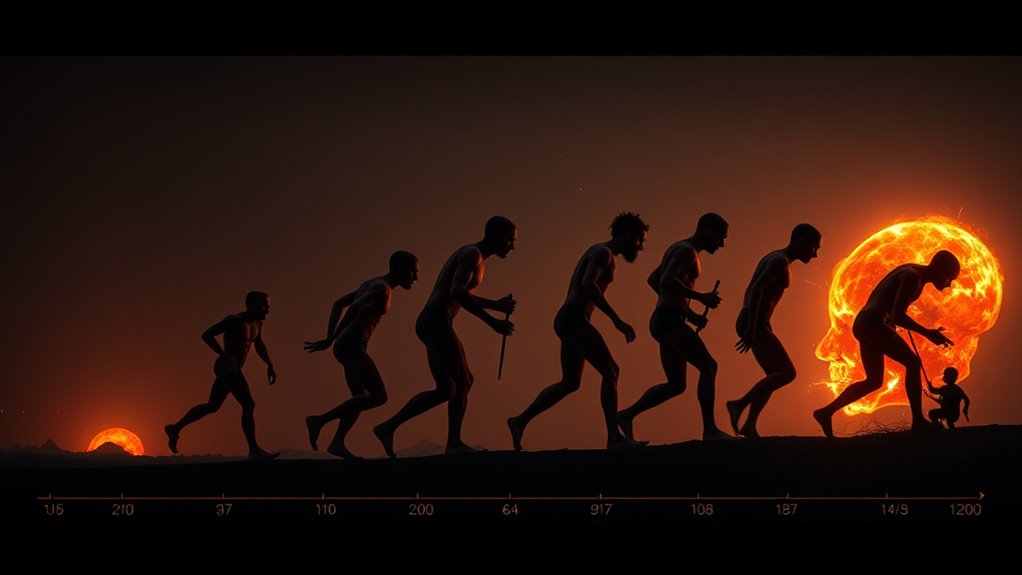
Exploring the evolutionary timeline of humans reveals a fascinating journey that stretches back millions of years. You'll find that early hominins, like Australopithecus, laid the groundwork for our lineage. These ancestors began adapting to an upright posture around 6 million years ago, which allowed them to walk on two legs. Notably, the earliest modern humans emerged in Africa around 300,000 years ago, marking a significant milestone in our evolutionary history.
As you dive deeper into the timeline, notice how significant developments marked each phase of evolution. The emergence of the Homo genus introduced species like Homo habilis around 2.5 million years ago, who crafted stone tools and showcased early intelligence. By 1.8 million years ago, Homo erectus appeared, with advancements like fire control and complex tools.
Here's a quick overview of key evolutionary milestones:
| Time Period | Hominin Species | Key Developments |
|---|---|---|
| 7–4.3 million years | Basal Hominins | Early human-like species |
| 2.5–1.65 million | Homo habilis | Use of stone tools |
| 300,000 years ago | Modern humans | Emergence of anatomically modern humans |
Fast forward to about 300,000 years ago, and you'll see the rise of modern humans. This period marked the beginning of symbolic culture and language. With the extinction of Neanderthals around 28,000 years ago, modern humans continued to evolve, eventually leading to the development of agriculture and societies we recognize today.
Burial Practices Throughout History
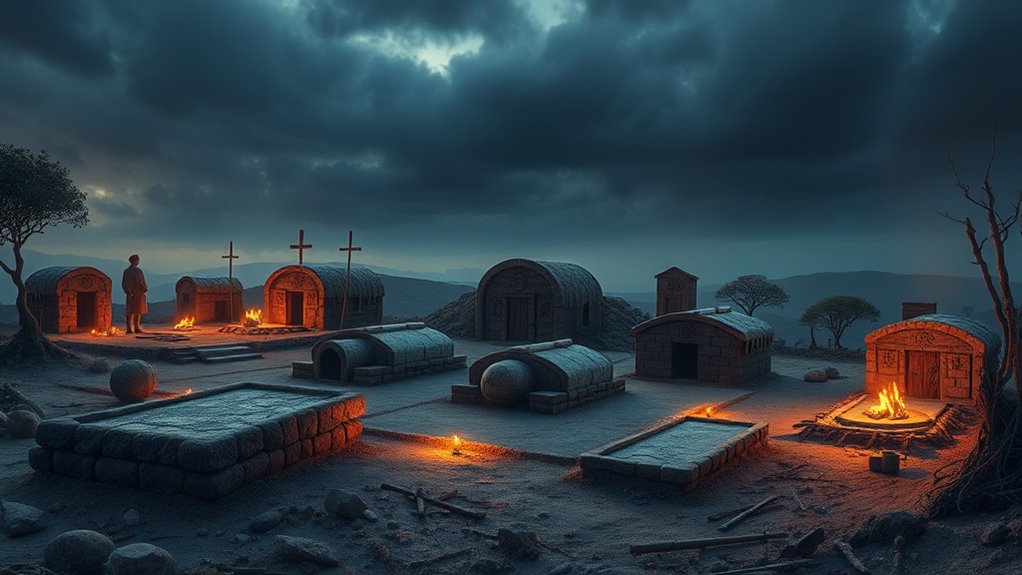
As humans evolved, their relationship with death and the afterlife became increasingly complex, leading to the development of varied burial practices across different cultures and time periods. You might find it captivating that early human burials in Eurasia ranged from simple graves to ornate ones, often reflecting cultural significance. While some individuals were buried with items of daily life, others received more elaborate goods. Notably, men were buried more frequently than women, and infant burials occurred sporadically. In fact, most burials included everyday items rather than elaborate goods, emphasizing a practical approach to burial customs.
When comparing these practices with Neanderthals, you'll notice similarities. Both groups buried their dead in pits alongside household items, suggesting shared beliefs in the afterlife. In fact, some modern human burials echo these simpler Neanderthal rituals, emphasizing a continuity in burial customs.
Moreover, there were other hominids, like Homo naledi, who engaged in complex burial rituals that predated known human practices by a thousand years. These hominids not only marked graves but also used fire and engravings, showcasing behaviors typically associated with larger-brained species.
Geographically, burial practices varied widely. In some regions, like Russia and Italy, ornate burials were anomalies, while in China, hanging coffins from the Tang dynasty tell a different story.
These traditions highlight the diverse cultural significance of burial rituals, illustrating how societies express their beliefs about death and the afterlife in unique ways.
Limitations of Historical Knowledge
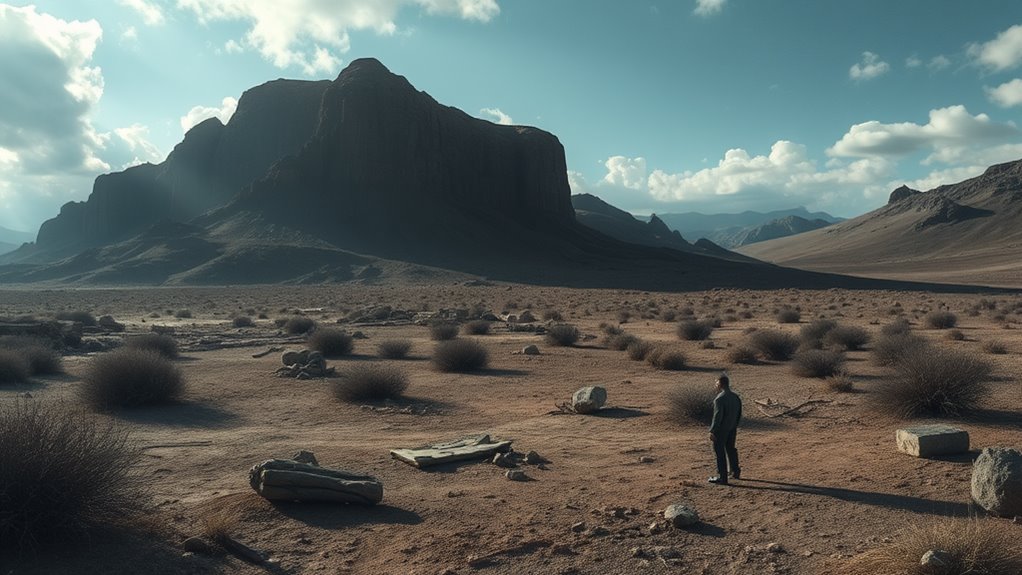
Historical knowledge is inherently constrained by the limitations of available evidence and source materials. You'll find that written records only date back about 5,000 years, originating from ancient Egypt and Sumer. These early documents tend to focus on the lives of the affluent, often detailing property, cattle, and crops. Because literacy was limited, the experiences of ordinary people are frequently overlooked in these accounts.
Moreover, the quality of source materials can vary greatly. While primary sources provide invaluable insights, they're often lost, inaccessible, or exist only in fragments. Secondary sources may offer a broader perspective, but they lack the immediacy of firsthand accounts and can be influenced by the biases of their authors. Eyewitness reports, such as memoirs or interviews, often arise years after the events they describe, which can distort the facts.
Chronological clarity emerges only after specific historical eras are established, making it tough to accurately reconstruct events before written records existed. This limitation means historians must rely on archaeology and anthropology, which analyze material objects and modern societies to fill in the gaps. For instance, the first evidence of homicide, which dates back 430,000 years, provides insight into early human interactions and mortality, reflecting the deep roots of human existence in our understanding of history.
Ultimately, interpreting history is a complex endeavor. You must consider the context in which sources were created, recognizing that time can alter perceptions of events. Different historians may interpret the same evidence in diverse ways, highlighting the subjective nature of historical knowledge.
These limitations remind us that our understanding of the past is often incomplete and shaped by the available evidence.
Frequently Asked Questions
What Were the Causes of Death in Early Human History?
In early human history, you'd face various causes of death. Natural disasters could wipe out entire communities, while hunting accidents often led to injuries or fatalities.
Food scarcity posed a constant threat, making survival challenging. Additionally, intergroup conflict frequently resulted in violence, causing further loss of life.
These factors combined created a perilous existence, where every day could bring new dangers and uncertainties, shaping the lives of those who lived during that time.
How Did Early Humans Perceive Death and Dying?
Early humans had complex perceptions of death shaped by spiritual beliefs and cultural perspectives.
You'd see death as both a natural part of life and a change, influencing rituals and memorial practices. Some communities honored the deceased through elaborate ceremonies, while others feared their spirits might linger.
These varying views helped you navigate the emotional toll of loss, fostering a connection between the living and the dead, and shaping societal norms around death.
Were There Any Rituals for the Deceased in Prehistoric Times?
In prehistoric times, purposeful practices and poignant rituals surrounded death.
You'd find burial practices that showcased care and community. Neanderthals, for example, adorned graves with funerary artifacts like stone tools and animal bones, suggesting deep respect for the deceased.
Similarly, Chinchorro mummification displayed intricate methods of preservation.
These early customs highlight humanity's enduring connection to the departed, revealing a profound understanding of life's fragility and the significance of honoring those who've passed.
How Did Death Impact Early Human Societies and Communities?
Death markedly impacted early human societies, shaping their social dynamics and cultural practices.
You'd see communal grieving as a way to bond and support each other during loss, reinforcing community ties. This collective mourning not only honored the deceased but also helped individuals process their grief.
Burial rituals emerged, reflecting death's importance and the respect for the lost, ultimately influencing their beliefs and traditions surrounding mortality and community cohesion.
What Roles Did Disease and Environment Play in Early Human Mortality?
You might think early mortality was solely about life expectancy, but disease transmission and environmental factors played massive roles.
Pathogens thrived in unsanitary conditions, leading to rampant infections that claimed countless lives. Contaminated water sources, for instance, were breeding grounds for diseases like cholera.
Additionally, climate changes and agricultural failures strained resources, further exacerbating mortality rates. These elements intertwined, shaping early human societies and their struggle for survival amidst constant threats.
